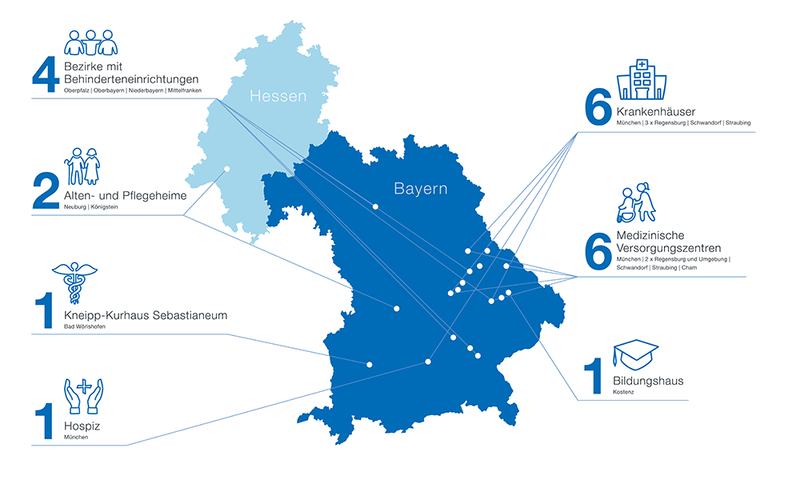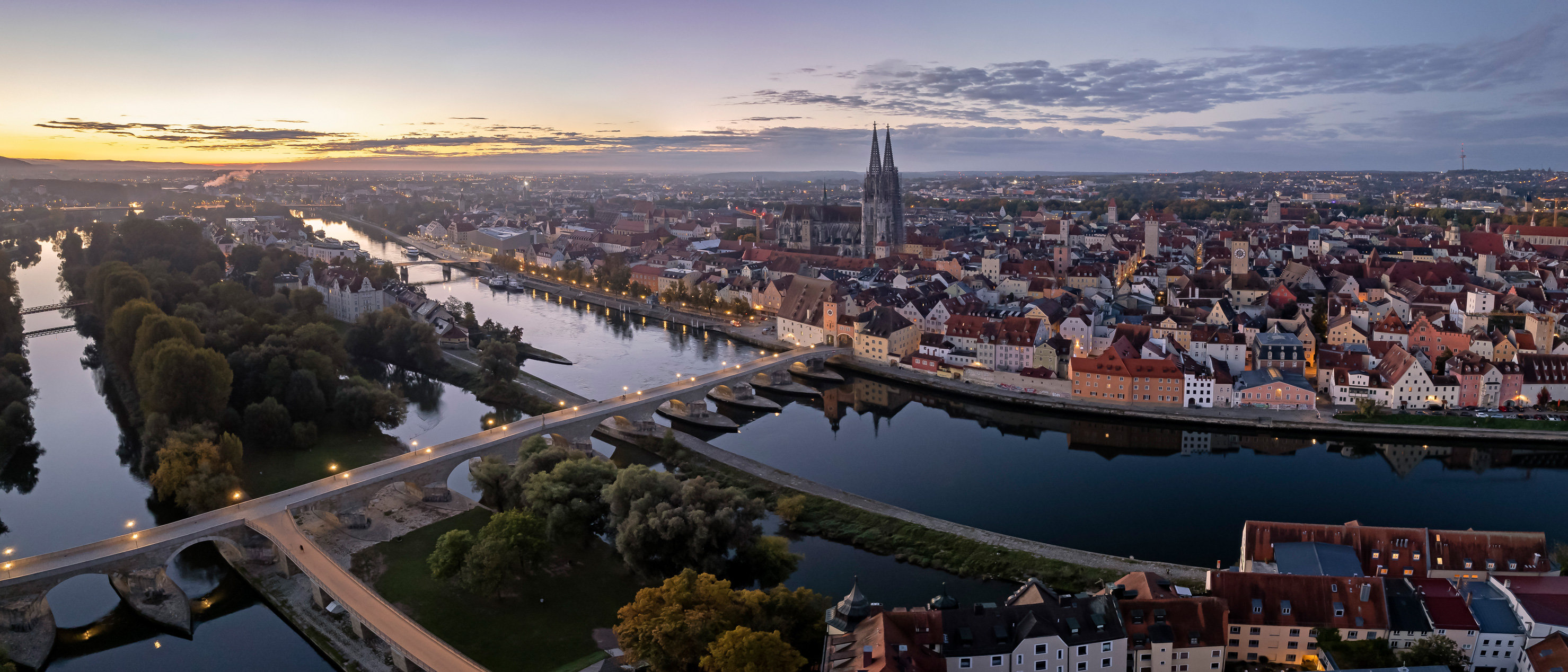Bavarian Province of the Order

The main activities of the Bavarian Province of the Order are in the hospital sector and in helping people with disabilities.
The Hospitaller Order of St. John in Bavaria is currently responsible for hospitals in Regensburg, Munich, Straubing, and Schwandorf. Facilities for people with disabilities operated by the Order can be found in Upper Palatinate, Upper Bavaria, Middle Franconia and Lower Bavaria, and old people's and nursing homes in Neuburg an der Donau and in Königstein (Taunus). The Sebastianeum in Bad Wörishofen also belongs to the Province of the Order - there is furthermore a conference and recreation centre in Kostenz. In addition, the Order runs an inpatient hospice in Munich, is involved in helping the homeless in the Bavarian state capital and is active in open work with the disabled in the district of Cham. The Hospitaller Order of St. John has transferred some of the facilities to non-profit limited companies under German law (gemeinnützige GmbH) in order to secure them for the future. More than 10,000 people are employed in the facilities.
Following in the footsteps of its founder, the Hospitaller Order of St. John strives to respond to the needs of our time. For example, the Brothers of St. John are among the pioneers of the hospice movement in Bavaria, opened the first palliative care unit in the Free State of Bavaria at their Munich hospital in 1991, and are involved in projects with medical assistance for the homeless and houseless.
Further information: www.barmherzige.de


Barmherzige Brüder gemeinnützige Träger GmbH
Barmherzige Brüder gemeinnützige Träger GmbH employs around 10,700 people in Bavaria. In the hospital sector, Barmherzige Brüder gemeinnützige Träger GmbH is divided into Barmherzige Brüder gemeinnützige Krankenhaus GmbH and Klinikum St. Elisabeth Straubing GmbH.
Barmherzige Brüder gemeinnützige Krankenhaus GmbH includes the hospitals Krankenhaus Barmherzige Brüder München, Krankenhaus Barmherzige Brüder Regensburg, Klinik St. Hedwig in Regensburg and Krankenhaus St. Barbara in Schwandorf, each with a 100 percent share, and Paul Gerhardt Haus Regensburg with an 80 percent share. Klinikum St. Elisabeth Straubing GmbH is a 90 percent subsidiary. In total, Barmherzige Brüder gemeinnützige Träger GmbH thus operates 2,150 beds in the hospital sector. Patient care in the hospitals is supported by six medical care centres and a service company.
The hospital network employs a total of more than 8,100 people. We treat about 400,000 outpatients and inpatients per year.
The Barmherzige Brüder gemeinnützige Träger GmbH also includes the Barmherzige Brüder gemeinnützige Behindertenhilfe GmbH. It provides accommodation for 2,800 people with disabilities in the regions of Central Franconia, Lower Bavaria, Upper Bavaria, and Upper Palatinate with the respective main locations Gremsdorf, Straubing, Algasing and Reichenbach in the areas of living and care, special education facilities, workshops, technical schools, and outpatient assisted living.
Further information: www.bb-krankenhausverbund.de, www.barmherzige-behindertenhilfe.de
The SURROUNDINGS

Just imagine: You know Regensburg, St. Peter's Cathedral, the Stone Bridge from pictures or from your own visit and you think it's all so wonderful that you sometimes even feel a little uncomfortable. Somewhere you might be dangerously close to the cliché. And then really everyone likes the city on the Danube. In fact, the UNESCO World Heritage is no longer an insider tip. But they still exist - the places where the alleys whisper, where walks become discovery tours, and where a very special magic wafts through the historic walls. Regensburg is one such place. Some call the first Bavarian capital "the best-preserved medieval city", others "Germany's medieval wonder". Both are right.
Admittedly, it is a little off the beaten track. But it is in the centre of Europe. And a visit to this lively city in the heart of Europe is always worthwhile. Even more so because it is conveniently located in a road network between Munich, Frankfurt, and Prague. Not only the architecture conveys Italian flair to the visitors of this city – it is also the way of life that Regensburgers indulge in during the summer that reminds of life under the southern sun: they seize every opportunity to celebrate big street festivals, be it jazz, art, an anniversary, or old traditions. And the fact that Regensburg is Germany's city with an above-average variety of culinary specialities is easy to notice and can be enjoyed in the street cafés, pubs, restaurants, and the many shady beer gardens at every turn.

The best way to get closer to the heart and nature of Regensburg is to take a guided tour of the city: old walls and historical events, an eventful past and amusing anecdotes, hidden backyards and secluded, narrow alleys – all this is revealed to visitors in an entertaining tour of a good one and a half hours. This is the best way to get a behind-the-scenes look at this young, dynamic city and a good introduction with impulses to experiencing it even more intensively on one’s own. It is also the ideal start to understand what makes the old city so young and how the people of Regensburg and the many "newcomers" know how to enjoy the city and their lives.

Bild: Steinerne Brücke von oben
But Regensburg offers more than city life, as its attractiveness does not end at the city boundaries. Located in the midst of the river valleys of the Danube, Regen, Naab and Laaber, the city offers the cultural and gastronomic amenities of a large city and the recreational opportunities of different landscapes. The nature park Bavarian Forest or the Danube Gorge near Kelheim are only a few kilometres away.
Regensburg is bursting with uniqueness: it is considered the best-preserved medieval city with the oldest preserved stone bridge in Germany, the Porta Praetoria as the oldest high-rise building in Germany, Thurn and Taxis Palace as the largest inhabited palace in Europe, the historic Imperial Chamber (Reichssaal) as the seat of the Perpetual Imperial Assembly and the first German or European parliament. The oldest church music college in the world is also located here, as is the oldest café house in Germany. The "document Neupfarrplatz" represents the largest excavation of a medieval Jewish quarter.
Source: www.tourismus.regensburg.de
About MARINAFORUM
Modern and bright premises with a touch of history that is tangible - this is the best way to describe the ambience of the marinaforum Regensburg. This aura lends every event that certain something.

A large hall and a small forum, workshop rooms and the open gallery offer plenty of space for events of all sizes. The good accessibility allows a relaxed arrival. The marinaforum Regensburg is easy to reach even by public transport.
The marinaforum Regensburg has not only been designed barrier-free in cooperation with expert bodies, including the Advisory Council for People with Disabilities of the City of Regensburg, but is also extremely attractive.
 Large hall
Large hall
Centrepiece of marinaforum Regensburg with 608 sqm.
 Small forum
Small forum
The small forum – for up to 170 people on 142 sqm.
 State-of-the-art technology
State-of-the-art technology
The marinaforum offers a wide range of state-of-the-art conference technology.
